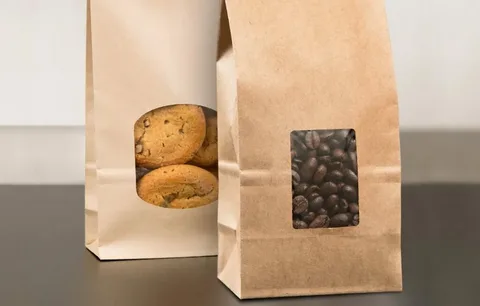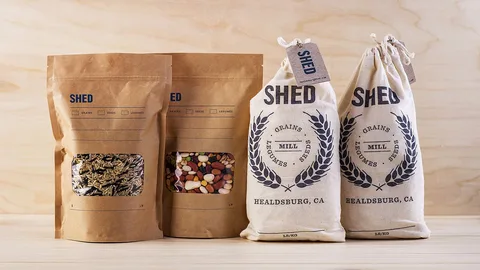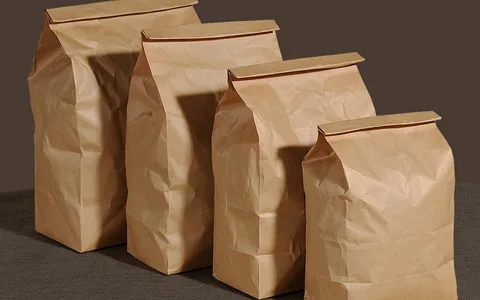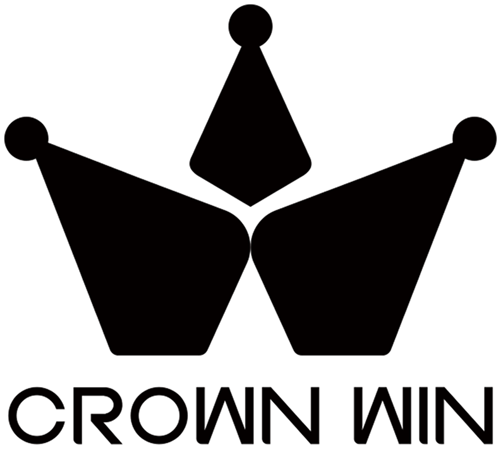Introduction
A walk along any grocery aisle in the current world and you are sure to discover one thing, and that is that they are getting much more demanding about their packaging selections, as 73 percent of all the shoppers around the world are willing to pay increasingly more to have their products packaged in environmentally friendly containers. This has altered consumer awareness and has seen the emphasis put on bagged packaged goods, with brands competing to match in terms of functionality, affordability, and environmental concern.

Packaged goods that are bagged include those items that are packaged in flexible packaging bags, like plastic films, paper sacks, or composite materials that make a pouch or bag-like container. They are flexible, unlike the hard packaging, such as bottles or boxes, and follow the shape of their contents, being able to be filmed with a variety of options, such as heat sealing, adhesive seals, or mechanical fasteners.
This issue is more than timely because brands are under pressure to cut down on packaging waste, ensure their products comply with the new rules, and meet consumer needs of environmentally friendly alternatives, and at the same time, keep their products safe and shelf-ready in the increasingly competitive market.
Background / History

The history of bagged packaging dates back many centuries ago with the primitive cloth sacks and paper bags used to store bulk items such as flour, grain, and sugar. These primitive types of flexible packaging had more utilitarian functions as they helped to preserve goods during transportation and preservation of goods and enable easy handling of loose goods.

The real revolution in packaging came in the mid-20th century with the introduction of synthetic polymers. In the 1930s, polyethylene was invented, and the industry changed because it provided better moisture barriers, durability, and cost-effectiveness than traditional materials. Plastic bags had become common in various industries, such as food packaging to industrial use, by the 1960s.
Plastic change Recycling Over the past number of decades have experienced unprecedented change due to consumer awareness of the environment, regulatory pressure, and changing consumer expectations. The Single-Use Plastics Directive of the European Union, California plastic bag laws, and increasing worries about the environmental impact of plastic pollution in the oceans have also driven the industry toward biodegradable solutions, recycling-based design solutions, and novel methods of barrier.
Materials Used in Bagged Packaging

There is also a wide variety of materials used in modern bagged packaging; each is designed to perform certain functions. Plastic films are still common, with high-density polyethylene (HDPE) being a promising chemical-resistant resistant used in household items, and low-density polyethylene (LDPE) is flexible and used in food products. New bioplastics based on corn starch, sugarcane, or other vegetable materials have the same functionality with better end-of-life properties.
Laminated films and metallized barriers are advanced engineering products, where a multilayer is used to provide excellent oxygen and moisture barriers. Mylar films are available with a superior barrier to sensitive products, whereas the aluminum foil laminates have complete light, gas barriers for high-end applications.

The paper segment has reemerged with revolutions in kraft paper treatments, integration of recycled contents, as well as compostable coating. These materials meet the needs of consumers who prefer natural packaging, while also ensuring that they meet the required protective purposes.
The recent innovations are edible packaging films that are produced using seaweed or rice, single-use water-soluble materials, and smart materials that change color upon exposure to freshness or heat, which is the new horizon of flexible packaging technology.
Types of Bagged Packaged Goods (by Product Category)

The largest category of bagged packaged goods is that of food and snack products, which includes the entire gamut of items that range from potato chips and nuts up to dried fruits, coffee beans, and frozen vegetables. Such applications need to have special barrier characteristics to preserve freshness, inhibit oxidation, and long shelf-life and convenient portion control, and resealability.
Packaged in bagged forms, whether it is dry kibble or soft treats, pet food and treats have adopted the use of special films that avoid the intrusion of pests, and ensure the food is not spoiled by outside influences. The expanding market of premium pet food has been the force behind innovation in resealable closures and portion-controlled packaging options.

Garden and landscaping products such as the potting soil, fertilizers, seeds, and mulch products are dependent on bagged packaging to facilitate convenient handling and protection against the weather. To resist hard handling and outdoor storage, these applications are usually made of heavier-gauge material.
Flexible packaging is being used in household goods like laundry detergents, cleaning products, bath salts, and personal care items due to their space savings and ease of use. Special packaging needs have been developed to protect children by the use of child-friendly packaging, such as detergent pods that also safeguard against moisture.

Hardware components and non-consumable items, such as craft supplies and automotive parts, are the other beneficiaries of the lower cost of bagged packaging and the ability to use clear films to make the product visible and identifiable, as well as customizable in terms of size.
Bagged vs. Boxed (or Other) Packaging

Bagged packaging is much better in terms of cost, and the cost of material is normally 40-60 percent less than rigid containers. These savings are compounded with production efficiency since flexible packaging lines are faster and need less storage space when empty containers are involved. Multiplication of shipping advantages is further, since bags fit product forms that remove void fill and use the maximum amount of the trailers.

The benefits of storage and transport are spread over the entire supply chain. The bagged goods have the benefits of saving space for retailers and the option of compressing empty bags to be disposed of by consumers. The distribution centers are able to have increased density in terms of inventory, and this saves warehousing costs, enhancing logistics efficiency.
The property of protection depends greatly on the choice of materials of construction. Although rigid packaging has better crush protection, modern barrier films can protect against moisture, oxygen, and light as well as allow equal or better protection. Multi-layer structures reach the level of performance that has only been possible previously with rigid containers.

The convenience considerations given by the consumers are more inclined towards flexible packaging by means of having innovations of resealable closures, portions of packages, and integrating ergonomic designs. Pour spouts, tear strips and easy-open add value to the user experience without stopping package integrity.
The digital printing technologies have increased the potential of branding flexible packaging in many ways, including shorter production lines, print-on-command options, and intricate graphics that can be seen as challengers to the discipline of rigid packaging and provide more distinctive tactile and interactive experiences.
Benefits of Bagged Packaged Goods
The benefits of cost are spread through all the areas of implementation of bagged packaging. It has always had lower manufacturing costs since the process of manufacturing is easier and the materials used are fewer. The efficiencies in shipping mean less carbon footprint and costs of transportation because more units are loaded into a single container. The advantages of the storage savings to the manufacturers, retailers, and consumers include optimization of space and minimal carrying costs in the inventory.
Consumer convenience benefits keep on increasing with the introduction of new types of closures, portion control functions, and portable forms. Zippers that are resealable help preserve the products and present numerous opportunities for use. Lightweight constructions minimize carrying strain, whereas conformable shapes fit well in refrigerators, pantries, and travel bags.
Sustainable materials can bring in environmental benefits when they are selected in a reflective manner. Less material is used than in hard packaging, which will have a great impact on reducing environmental effects. Mono-material buildings can be more easily recycled, and compostable alternatives can offer end-of-life services to organic waste streams.
Digital printing, custom sizing, and special structural designs all make brand flexibility reach new heights. Creative shapes, open windows, and interactivity of the brand can help achieve a unique shelf presence at a cost-competitive price and flexible production.
The preservation advantages are related to extending the shelf life of a product by maintaining the strain on the product allowance. Many rigid packaging formats can be surpassed by modified atmosphere packaging techniques, the use of oxygen scavengers and moisture barriers, and the quality of the product can be preserved, as well as the amount of food waste decreased.
Challenges / Considerations
The most challenging issue currently confronting bagged packaging is the environmental concern. The non-recycled multi-layer films cause issues with disposal, and negative consumer perception is the result of plastic pollution concerns. Mixed material constructions also make it difficult to recycle products, and, in most cases, they end up in the landfills despite some attempts at recycling.
The regulatory environments also keep changing fast, as plastic bans, extended producer responsibility, and the use of labels provide complexity in compliance. Brands have to negotiate in different regional regulatory conditions, and remain global in supply chain efficiency and cost competitiveness.
The supply chains of materials experience instability with supply and prices and especially regarding sustainable options. Bio-based materials are usually sellable at high prices and have capacity limitations. Materials that are petroleum products are affected by price variations that are linked to the energy market, which makes them difficult to forecast.
The problem of consumer perception with regard to the claims of recyclability and greenwashing accusations should be handled with caution. Open and transparent communication regarding the packaging restrictions and correct disposal is a necessity in terms of brand trust and compliance.
There are functional constraints that pose a continuous challenge to some applications. Material solutions could be more costly or involve compromises in puncture resistance, high temperature stability, and barrier performance. Sharp-edged products and fine powders may be problematic with package integrity, whereas liquid applications require special sealing technologies.
Trends in Bagged Packaging
The recent wave of packaging innovation focuses on sustainability features, and brands invest a lot in compostable films, the incorporation of recycled materials, and mono-material designs, which enhance recyclability. Barrier coatings made of plants are also used instead of petroleum-based materials and meet performance requirements.
The integration of technology is evolving at a fast pace due to the smart packaging capabilities, such as freshness indicators, temperature sensors, and QR codes connecting to product details. Modified atmosphere packaging is not limited to the conventional food uses, to pharmaceuticals and consumer products.
The zero-waste movement is associated with the design of packages being refillable, the products being concentrated, and the removal of secondary packaging materials. Minimalist design focuses more on utility and less on visual elaboration and the application of materials.
Design innovations are aimed at the improvement of the user experience by means of the enhanced closure, portioning, and considerations of accessibility. Digital printing can be used to do mass customization and limited edition packaging, and it helps to be flexible in supply chains.
Both recyclable designs and take-back programs encourage investment because of regulatory trends toward long-term producer responsibility and circular economy principles. Plastic credit systems and packaging taxes affect the choice of materials and the construction design.
Environmental Impact & Best Practices
Lifecycle assessment indicates that there are complicated tradeoffs between material type, in terms of the paper-based packaging frequently using more energy and water to manufacture, yet having superior end-of-life properties. Plastic options are much superior to performance per gram of material, but the challenge lies in disposal to most waste management systems.
Environmental footprint can be reduced by brands by making appropriate material choices, designing for a purpose, and integrating in the supply chain. The use of lightweighting lowers material consumption, which does not affect performance, besides regional sourcing lowers transportation effects. The rules of design to be recycled allow the integration of waste streams.
Third-party certifications present viable authentication of environmental statements. Paper-based materials are certified by the Forest Stewardship Council (FSC), which assures responsible forestry. Claims on biodegradability are certified by the Biodegradable Products Institute (BPI) under certain circumstances. How2Recycle labels show consumers the correct ways to dispose.
Environmental benefit requires consumer education. Clear recycling guidelines, good disposal guidelines, and clarity regarding material constraints should assist the consumer in making informed decisions and attain predetermined environmental results.
Future Outlook
The innovation in materials proceeds at an ever-increasing speed, with the seaweed-based films, mushroom materials, and sophisticated and efficient recycling technologies that decompose complex polymers into base chemicals that can be reused. The communication of nanotechnology could facilitate the development of ultra-thin barriers that are characterized by very good performance features.
The models of the circular economy are becoming more popular with the ideas of refillable packaging systems, deposits, and collection networks managed by its brand. Online technologies facilitate package tracking and product recall systems that may turn linear take-make-dispose into closed-loop systems.
The market growth projections are based on the continued growth due to the growth of e-commerce, sustainability needs, and cost constraints. In the Asia-Pacific, the potential is especially high with middle-income consumers being more inclined to demand premium packaging as they consider the environment.
Better brands will invest in research and development alliances, supply chain disclosure projects, and consumer education schemes. The prompt implementation of sustainable technologies and transparent communication regarding the packaging options will create a difference between those leaders and followers in the ever-competitive markets.
Conclusion
Bagged packaged goods constitute an active nexus of cost-effectiveness, consumer convenience, and environmental responsibility that remains constantly changing at a very fast rate, depending on market forces and regulatory demands. Although sustainability and functionality issues have remained relevant, recent advances in the field of materials science, design engineering, and recycling technologies have provided the prospects of more sustainable packaging solutions. Companies that adopt the practice of being transparent, investing in sustainable options, and are committed to educating consumers, but do not compromise product protection and cost adequacy will continue to be successful in this changing environment, and those who do not also pay attention to the environment have the potential to lose market presence in a more aware consumer world.






